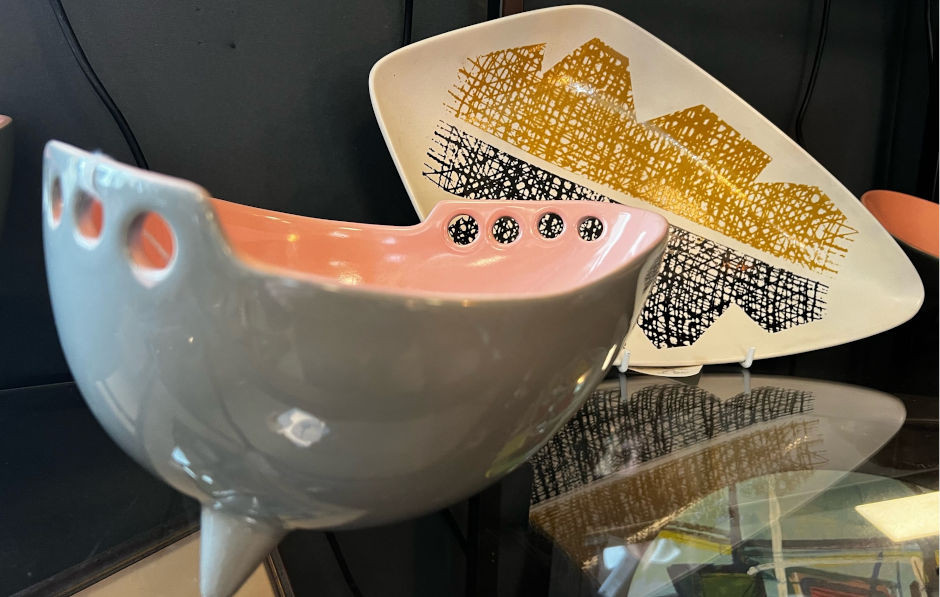
The latest in our series of antique dealer’s guides looks at 20th century ceramics and examines studio ceramics as well as 20th century ceramic artists and pottery factories.
What are ceramics?
When you hear the word ceramics do you think of pottery such as dinnerware (think Clarice Cliff), ornamental figures (Wade), or vases (Moorcroft and Grayson Perry)? Or do you think of larger sculptural pieces such as the work of American ceramic artist Robert Arneson? In fact, ceramic pieces or ceramic art is anything that has been made from clay.
The difference between studio pottery and production pottery
Production pottery is the name given to commercial pieces manufactured in a factory, while studio pottery is work that has been produced by individual craftspeople and artisans.
What are studio ceramics?
Dating back to the early 20th century, the British studio ceramics movement is attributed to Bernard Leach who established a pottery in St. Ives, Cornwall. Studio ceramics were produced by individual ceramic artists – both amateur and professional – who worked alone or in very small groups, and who were responsible for every step of the manufacturing process.
Notable 20th century ceramic studios
As well as the Leach studio, Troika was also based in Cornwall and was founded in 1962 by three studio potters from London. Troika pieces received critical and commercial acclaim with prestigious stores Heals and Liberty stocking their wares. Troika is characterised by two distinct ranges – rough textured pieces and smooth, glazed items. The modern, angular shapes of many of Troika’s pieces were not achieved by the clay being thrown but by moulds being used to create the pieces that would be assembled to create a sculptural piece. Troika closed in 1983.
Notable 20th century ceramic artists
Bernard Leach (1887-1979) – considered the founder of the British studio pottery, Leach worked out of his studio in Cornwall where he produced simple, utilitarian pieces. Today, the Leach Pottery is a museum, studio, gallery and shop.
Lucie Rie (1902-1995) - an Austrian refugée who came to Britain in the 1930s, Lucie Rie epitomises the cosmopolitan nature of the British studio ceramic movement, bringing European sensibilities to her work. An unlikely friend of Leach, Rie produced hand-thrown vessels such as bottles, bowls and pots, which featured bright colours in a modernist form.
Hans Coper (1920-1981) – another refugé, Coper was German born and produced wheel thrown pieces which were sculptural, unglazed and non-functional.
Famous 20th century pottery factories
When considering important potteries, thoughts turn to the great Staffordshire potteries, most often centred around Stoke-on-Trent.
Midwinter – from the famous Stoke-on-Trent stable of potteries, Midwinter closed in 1987 but its 20th century pieces still hold their prices with designs and shapes considered iconic and on-trend ‘retro’. Popular designs by in house artists include Zambesi, Domino, Riviera and Cannes.
Wade – known for their highly collectable Wade Whimsies which date from the mid-20th century. Whimsies were miniature figures still sought after today for the breadth of subjects covered and for the fact that they can be displayed easily.
SylvaC – Founded at the end of the 19th century by William Copestake and William Shaw, the name SylvaC was first trademarked in 1937 and pieces predating this were marked with ‘Silvo’. Producing highly recognizable dog and rabbit ornamental figurines in orange and green matt glazes, SylvaC also produced posy vases, bowls in the shape of vegetables and sculptural planting vases.
Poole – in 2023, Poole Pottery celebrates its 150th anniversary and was one of the leading potteries throughout the 20th century, at the forefront of ceramic design. The factory was prolific in its output, producing architectural pieces, tiles, sculpture, vases and chargers.
Notable 20th century ceramic factory artists
Susie Cooper (1902-1995) was a well-renowned and prolific ceramic designer rather than a potter, who started her career painting the work of other potters. She established a studio where she painted her own designs onto plain, mass produced white pottery pieces. She worked for Wedgewood but left, preferring the fluidity of freelance work.
Clarice Cliff (1899-1972) is possibly the best known 20th century ceramic artist/designer. Clarice Cliff's work is recognised for its bright, bold colours and experimental and innovative shapes. She spent her entire working life at AJ Wilkinson, a pottery in Stoke-on-Trent, where she was given her own studio from where she designed such iconic patterns as Bizarre and Fantasque.
Charlotte Rhead (1885-1947) – another Staffordshire based artist, Rhead was employed by the Burleigh pottery and was a contemporary of both Cooper and Cliff. She also worked for Crown Ducal. At various stages of her career, Rhead worked as an enameller, a designer and an artist.
20th century ceramics at Hemswell Antique Centres
With over 500 pieces of 20th century ceramics available to view online, and hundreds more on display in our four buildings, you can browse iconic pieces from Moorcroft pottery, Beswick and Wedgewood plus many more. Our postal service ensures that items are delivered safely and securely, many for just £15 or why not visit us in person and spend the day perusing at your leisure, breaking up your visit with refreshments in one of our cafes?